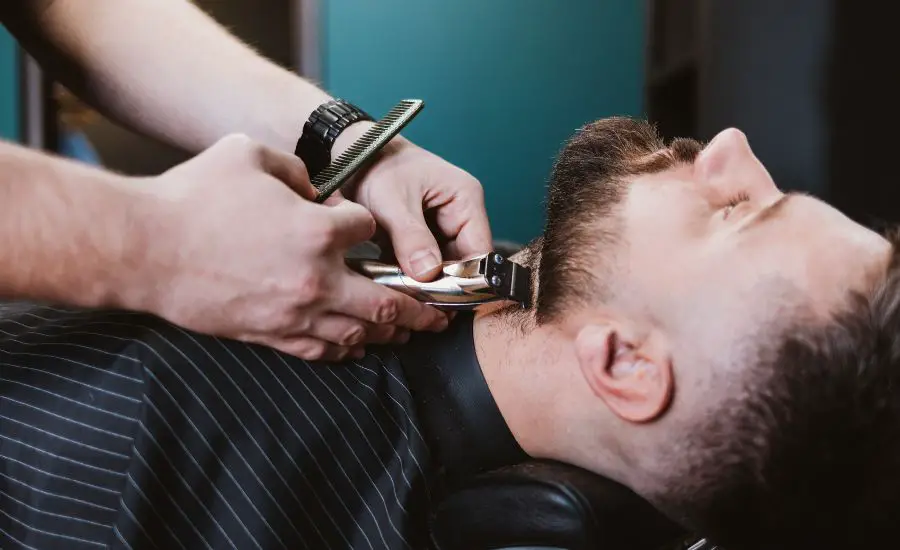Beards have stormed into the spotlight of modern culture, making a bold statement that harks back to rugged masculinity and timeless charm. Whether it’s a neatly trimmed stubble or a majestic cascade, beards are more than just a trend – they’re a style statement that bridges the gap between traditional and contemporary.
What is a forked beard? A forked beard, also known as the “French fork“, is a long beard that splits in the middle. Picture this: you’ve been cultivating your facial foliage with care, letting it flourish into an impressive display of manly charisma.

But just when you think you’ve mastered the art of beard grooming, you notice an unwelcome development – your once-impeccable beard is starting to split right down the middle. It’s as if your beard has decided to part ways, quite literally. In this article, we embark on a journey to answer the question “Why does my beard split in the middle?“.
We delve deep into the world of forked beards, exploring the anatomy, growth phases, and the vital role that proper care plays in maintaining a robust and handsome beard.
By understanding the root causes of beard splitting, we’re not just scratching the surface; we’re diving headfirst into the depths of beard wisdom to offer you practical solutions that will keep your beard looking its best.
Anatomy of beard hair
When your beard grows, it goes through distinct growth phases. From the sprout of stubble to the majestic mane, your beard’s evolution is a testament to your patience and commitment.
Here’s a truth that can’t be denied: a healthy beard is a result of proper care, much like a flourishing garden owes its beauty to meticulous nurturing.
Regular cleansing, conditioning, and moisturizing aren’t just rituals; they’re essential steps in ensuring your facial hair’s well-being. Neglect these, and you risk falling into the dreaded “split beard” pitfall.
Causes of split beards

What are the most common causes of the beard split? Let us explore the intriguing reasons why your long beard may decide to split down the middle and turn into a forked beard.
So, buckle up, fellow beard enthusiast, as we navigate through the intricacies of the forked beard and uncover the secrets to maintaining a beard that’s as captivating as it is commanding.
Genetics of the long beards
Even though there are many causes of split beards, when it comes to beard patterns, genes hold the cards, and a forked beard might just be your unique genetic dance.
The hair thickness and the way your beard grows are often influenced by your DNA.
On top of that, uneven brushing can exacerbate the fork, leading to a more prominent split beard.
Environmental factors: battling the elements
Dry and harsh weather conditions, especially during those chilly winter months or scorching summer days, can strip your beard of its natural moisture, leaving it vulnerable to splitting. Just like you’d protect your skin from the elements, your beard needs some tender love and caring too.
Fun in the sun can quickly turn into a beard nightmare. Unprotected exposure to UV radiation can weaken the structure of your hair, causing beard issues and making it more prone to splitting.
Life in the city comes with its share of challenges, including air pollution and contaminants that can settle on your hair. These unwanted guests can disrupt your beard’s natural balance and contribute to a beard split in the middle. It’s time to show your beard some extra love in the battle against urban grime.
Grooming habits: finding the right balance
We get it – you want your beard to look its absolute best. But too much of a good thing can lead to trouble. Overbrushing and excessive styling can put stress on your beard, weakening its structure and turning it into a French fork. Opt for a gentle touch and give your beard the breathing room it deserves.
Just like a car needs regular maintenance, your beard needs proper care, too. Improper washing and conditioning can strip away essential beard oil, leaving your hair parched and susceptible to beard splitting. Master the art of cleansing and moisturizing for a beard that shines with vitality.

Nutritional deficiencies: feeding your follicles
You’ve heard the saying, “You are what you eat.” Well, your beard echoes that sentiment. A balanced diet packed with vitamins and nutrients is the cornerstone of healthy hair growth. Neglecting your nutrition can lead to weak and fragile hair, resulting in a forked beard.
Your beard craves specific nutrients to thrive.
From biotin and vitamin E to omega-3 fatty acids, these building blocks contribute to strong and resilient hair that resists the dreaded beard split. Think of it as a power-packed meal for your facial follicles.
Hormonal imbalance: the beard’s internal symphony
Hormones play a crucial role in both head and facial hair. Testosterone, the primary male hormone, fuels beard growth. Fluctuations in hormonal levels can impact the quality of your beard hair, making it more susceptible to splitting.
Hormonal imbalances caused by factors like stress, medications, or health conditions can wreak havoc on your beard. When your internal symphony is out of tune, your facial hair pays the price. Hormonal harmony is key to maintaining a healthy and split-free beard.

Preventive measures and solutions
Bid farewell to your forked beard by embracing a proper hair care routine. Cleanse and condition your beard with products designed specifically for it.
A gentle touch and the right technique can make all the difference in your quest to prevent beard splits. Pay a visit to beard groomers if you can spare the time.
Not all grooming products are created equal. Opt for quality beard products, such as beard wax, oils, and balms that are enriched with natural ingredients, offering your hair the hydration and nourishment it craves. Say no to harsh chemicals and yes to the goodness of nature.
Moisture is your beard’s best friend. Regularly apply beard oil or balms to keep your hair well-hydrated and protected from the elements. This simple step can go a long way in preventing a forked beard and promoting a healthy, lustrous mane.
Healthy lifestyle choices: fueling beard resilience
Remember, a healthy beard starts from within. Fuel your body with a balanced diet that’s rich in vitamins and minerals essential for hair health. Your beard will thank you by staying strong and split-resistant.
Hydration and stress management are your allies in the battle against the French fork. Keep yourself well-hydrated, and find healthy ways to manage stress. A happy body translates to a happy, resilient beard.
Trimming and styling techniques: keep forked beard at bay

Trimming isn’t just for style; it’s a critical aspect of beard maintenance. Long beards tend to be more prone to forking.
Regular trims help prevent split ends from traveling up the hair shaft, keeping your beard looking neat and healthy.
While experimenting with beard styles is exciting, excessive heat styling and chemical treatments can take a toll on your facial hair’s health. Embrace natural beard styles, reduce hair dryer usage, and give your beard a break from harsh treatments.
Here’s a stylish trick: tame your wayward hair growth with a beard ponytail. Gently gather the hair surrounding the beard split and secure it with hair ties. While commonly associated with crafting a dashing handlebar mustache, beard wax products are also handy to prevent and control your forked beard.
Comb or Brush Carefully
Use a quality beard comb or brush to detangle your beard gently. Start from the ends and work your way up to avoid stressing the hair in the middle. This helps distribute natural oils evenly and prevents knots and tangles that can lead to split ends.
Avoid Overwashing
Overwashing your beard can strip it of its natural oils, leaving the hair dry and more susceptible to splitting. Instead of daily washing, opt for a mild, beard-friendly shampoo and limit washing to 2-3 times a week. This helps maintain a healthy balance of natural oils, preventing excessive dryness that can lead to split ends.
Additionally, when washing, be gentle to avoid stressing the hair follicles and consider using a conditioner to further enhance moisture retention and promote beard health.
Limit Heat Exposure
Limiting heat exposure is vital for preventing split ends in your beard. Excessive use of heated styling tools can weaken the hair cuticle, making it more prone to breakage and splitting. If you must use heat, always apply a protective product before styling, and try to keep the temperature moderate.
Additionally, consider incorporating heat-free styling methods into your routine, such as air-drying or using low-heat settings, to minimize the risk of heat-induced damage and maintain the overall health and integrity of your beard.

FAQ
How do I stop my beard from splitting?
Putting an end to the dreaded split in the middle is within your grasp, and it starts with a commitment to proper beard care. Embrace a well-rounded routine that involves gentle washing, regular conditioning, and the use of natural products like beard wax, oils, and balms.
Avoid over-styling, excessive heat, and harsh chemicals. Trim your beard regularly to maintain a uniform length and hair density, and consider seeking expert advice from dermatologists or professional beard groomers for advanced solutions.
Why do my beard hairs break?
Beard hairs can be finicky, and breakage often stems from a combination of external and internal factors. Exposure to harsh weather, pollutants,and UV radiation weakens the hair shaft, making it prone to breakage. Unhealthy grooming habits, like aggressive brushing and excessive heat styling, can also take a toll.
Additionally, poor nutrition and hormonal imbalances play a role. To minimize breakage, adopt a holistic approach – shield your beard from environmental stressors, handle it gently, nourish it from within, and seek professional help for beard guidance when needed.
What is a forked beard?
A forked beard, often referred to as a “split beard,” is a distinctive style where the beard splits or forks in the middle, creating a prominent division down the center of the chin. This style can be intentional or a result of natural growth patterns.
Some men embrace the forked beard as a unique and striking look, while others prefer a more uniform appearance. Proper grooming, trimming, and styling techniques can help you rock the forked beard with confidence and flair.
Why doesn’t hair grow in the middle of my beard?
The absence of hair growth in the middle of your beard can be attributed to a combination of genetic and hormonal factors. Just like some men experience patches of baldness on their scalps, beard growth can also have its variations. Hormonal imbalances, especially fluctuations in testosterone levels, can affect beard growth patterns and cause beard splits.
Conclusion: a splendid beard awaits
Your journey through the labyrinth of the forked beard has equipped you with knowledge and tools to reclaim beard greatness. Prevention is key to a splendid, split-free beard that commands attention.
So, fellow beard enthusiasts, stand tall, embrace the wisdom you’ve gained, and embark on a journey to beard glory. Let your facial hair be a canvas of your dedication, a testament to your grooming prowess, and a symbol of your unique style.
The split in the middle may have been a challenge, but with the power of knowledge and care, you’re destined to conquer it – one strand of the forked beard at a time.






